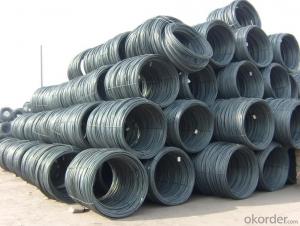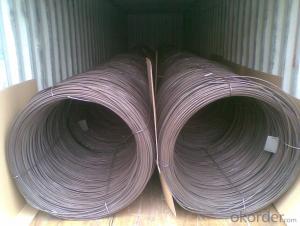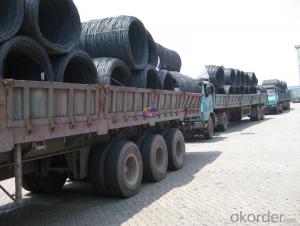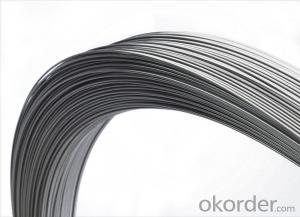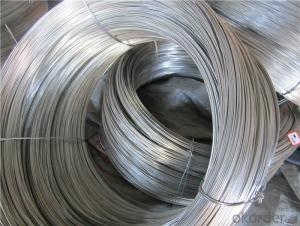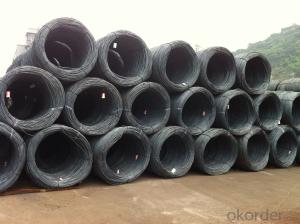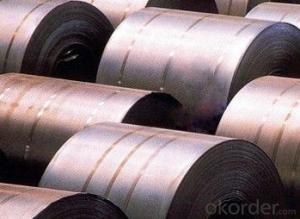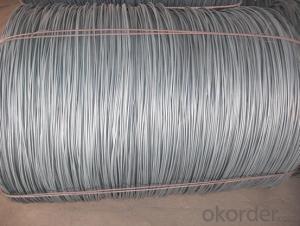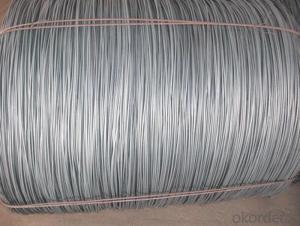SAE1006Cr Carbon Steel Wire Rod 17.5mm for Welding
- Loading Port:
- Shanghai
- Payment Terms:
- TT OR LC
- Min Order Qty:
- 100 m.t
- Supply Capability:
- 30000 m.t/month
OKorder Service Pledge
OKorder Financial Service
You Might Also Like
Item specifice
Description of SAE1006Cr Carbon Steel Wire Rod 17.5mm for Welding:
OKorder is offering Color Coated Steel Coil Prepainted Steel Coil at great prices with worldwide shipping. Our supplier is a world-class manufacturer of steel, with our products utilized the world over. OKorder annually supplies products to European, North American and Asian markets. We provide quotations within 24 hours of receiving an inquiry and guarantee competitive prices.
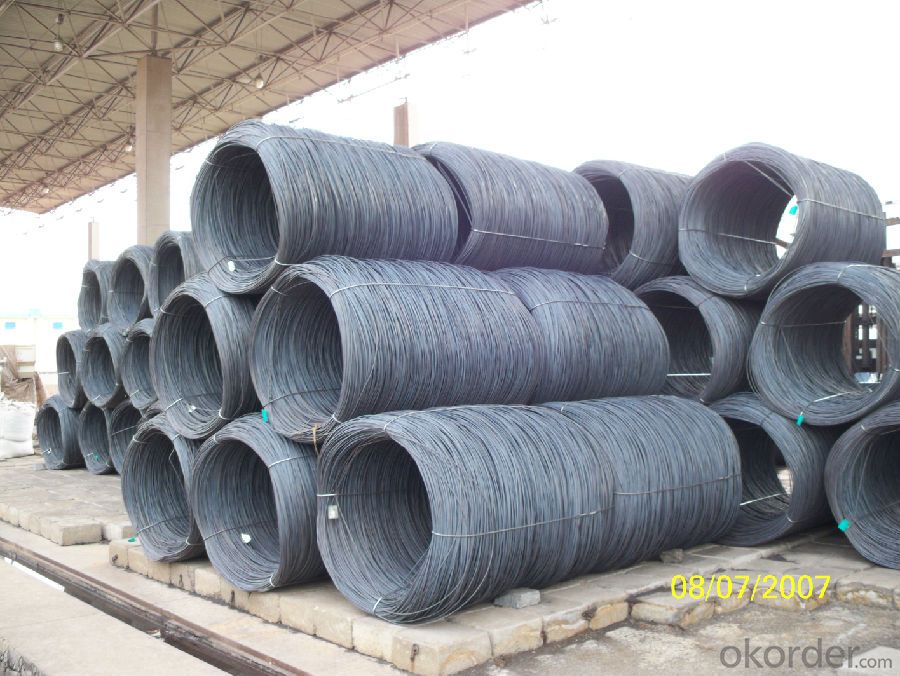
Applications of SAE1006Cr Carbon Steel Wire Rod 17.5mm for Welding:
Color Coated Steel Coil Prepainted Steel Coil are ideal for structural applications and are widely used in the construction of buildings and bridges, and the manufacturing, petrochemical, and transportation industries.
Main Product Features of SAE1006Cr Carbon Steel Wire Rod 17.5mm for Welding:
· Premium quality
· Prompt delivery & seaworthy packing (30 days after receiving deposit)
· Corrosion resistance
· Can be recycled and reused
· Mill test certification
· Professional Service
· Competitive pricing
Specifications of SAE1006Cr Carbon Steel Wire Rod 17.5mm for Welding:
1, Introduction: Color coated steel coils(sheets), i. E. PPGI, also called prepainted steel coils(sheets), are made of galvanized steel coils(sheets) with polymer coatings as surface. It's a new enclosure material and building board with characteristics of light-weighted, heat preserved&insulated, easily installed with bright colors.
2, Production Process: Pretreatment(Degreasing)_Drying_Chromating_Paint Basic Oil_Cooling_Drying_Color Coating_Cooling_Film-covering_Rolling Up
3, Characteristics:
Good at corrosion resistence. Besides zinc coating of the basic plate of galvanized steel sheet, the color coating as the surface has double lifetime to ensure better anticorrosion effect.
With excellent cold bending molded manufacturablity, PPGI products can be processed or directly used as final product. As being light-weighted and conveniently transported, they're widly used to replace wood to save energy.
4.There're thousands of colors can be chosen as per different application. Any color plays well in decoration.
No pollution with high recycling rate, PPGI coils and sheets are strongly recommended as enviroment-friendly products by the government.
5, eye bands and 4 circumferential bands in steel, galvanized metal fluted rings on inner and outer edges, galvanized.
| commodity | SAE1006Cr Carbon Steel Wire Rod 17.5mm for Welding |
| Techinical Standard: | JIS G3302-1998, EN10142/10137, ASTM A755 |
| grade | Q195,Q215,Q235,SAE1006,SAE1008 SAE1006Cr |
| Types: | Mesh welding |
| Base metal | galvanized, galvalume, cold rolled steel |
| Thickness | 0.14-1.0mm(0.16-0.8mm is the most advantage thickness) |
| Width | 610/724/820/914/1000/1200/1219/1220/1250mm |
| Type of coating: | PE, SMP, PVDF |
| Zinc coating | Z60-150g/m2 or AZ40-100g/m2 |
| Top painting: | 5 mic. Primer + 15 mc. R. M. P. |
| Back painting: | 5-7 mic. EP |
| Color: | According to RAL standard |
| ID coil | 508mm610mm |
| Coil weight: | 2--3MT |
| Package: | Properly packed for ocean freight exportation in 20'containers |
| Application: | Industrial panels, roofing and siding for painting/automobile |
| Price terms | FOB, CFR, CIF |
| Payment terms | 20%TT in advance+80% TT or irrevocable 80%L/C at sight |
| delivery time | 25 days after recepit of 20% TT |
| Remarks | Insurance is all risks |
| MTC 3.1 will be handed on with shipping documents | |
| We accept SGS certificatation test |
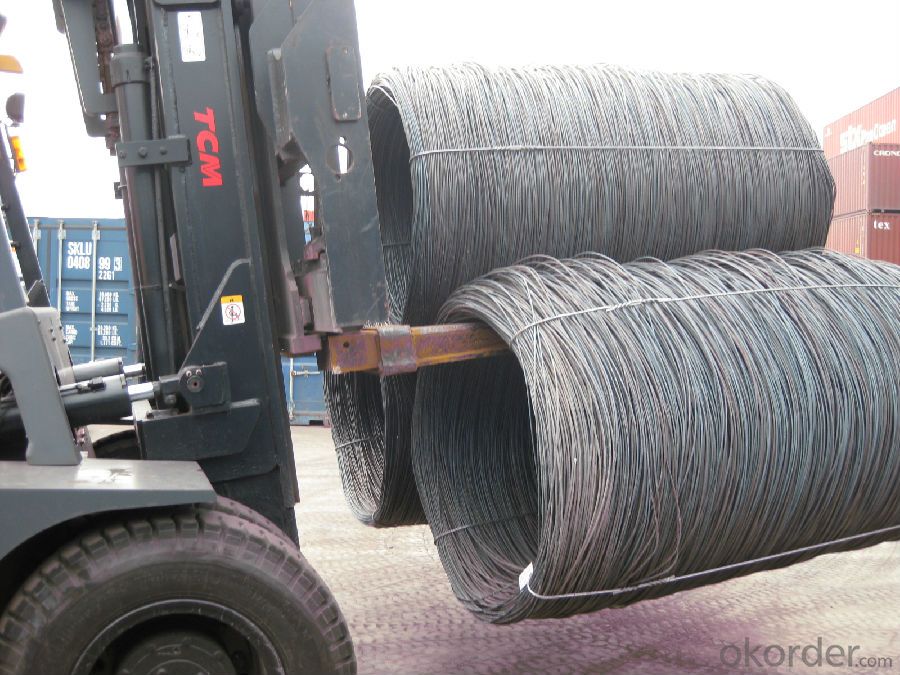
FAQ of SAE1006Cr Carbon Steel Wire Rod 17.5mm for Welding:
Q1: Why buy Materials & Equipment from OKorder.com?
A1: All products offered byOKorder.com are carefully selected from China's most reliable manufacturing enterprises. Through its ISO certifications, OKorder.com adheres to the highest standards and a commitment to supply chain safety and customer satisfaction.
Q2: How do we guarantee the quality of our products?
A2: We have established an advanced quality management system which conducts strict quality tests at every step, from raw materials to the final product. At the same time, we provide extensive follow-up service assurances as required.
Q3: How soon can we receive the product after purchase?
A3: Within three days of placing an order, we will begin production. The specific shipping date is dependent upon international and government factors, but is typically 7 to 10 workdays.
Q4: What makes stainless steel stainless?
A4: Stainless steel must contain at least 10.5 % chromium. It is this element that reacts with the oxygen in the air to form a complex chrome-oxide surface layer that is invisible but strong enough to prevent further oxygen from "staining" (rusting) the surface. Higher levels of chromium and the addition of other alloying elements such as nickel and molybdenum enhance this surface layer and improve the corrosion resistance of the stainless material.
Q5: Can stainless steel rust?
A5: Stainless does not "rust" as you think of regular steel rusting with a red oxide on the surface that flakes off. If you see red rust it is probably due to some iron particles that have contaminated the surface of the stainless steel and it is these iron particles that are rusting. Look at the source of the rusting and see if you can remove it from the surface.
- Q:What are the different surface defects in steel wire rod?
- Some of the different surface defects in steel wire rod include scratches, pits, seams, cracks, and scale.
- Q:What are the common industry competencies for steel wire rod manufacturers?
- Some common industry competencies for steel wire rod manufacturers include expertise in steel production and processing, knowledge of market trends and customer demands, ability to meet quality and safety standards, efficient supply chain management, strong technical skills in wire rod manufacturing processes, and the ability to innovate and adapt to changing industry needs.
- Q:How does the tensile strength of steel wire rod vary with different grades?
- The tensile strength of steel wire rod varies with different grades due to variations in the composition and processing techniques. Higher grade steel wire rod typically has a higher tensile strength, as it is made from stronger materials and undergoes stricter manufacturing processes. Lower grade steel wire rod, on the other hand, may have a lower tensile strength as it may contain impurities or have less stringent quality control measures during production.
- Q:How is steel wire rod used in the production of wire mesh for filtration?
- Steel wire rod is an essential component in the production of wire mesh for filtration. It serves as the raw material for manufacturing wire mesh, which is widely used in various industries such as mining, construction, and agriculture. To produce wire mesh for filtration, the steel wire rod goes through a series of manufacturing processes. First, the wire rod is heated and then rolled into thin strands, known as wire. These wires are typically of a consistent diameter and have a smooth surface to ensure high-quality filtration. Next, the wire is woven or welded to create the desired mesh pattern. The weaving process involves interlacing the wires over and under each other, forming a stable and durable mesh structure. Alternatively, the wires can be welded at their intersections to create a more rigid mesh. The steel wire rod used in the production of wire mesh for filtration is chosen for its specific properties. Steel is known for its strength, durability, and corrosion resistance, making it suitable for demanding filtration applications. Additionally, the wire rod can be further treated to enhance its performance, such as by applying coatings to improve resistance to abrasion or chemicals. Once the wire mesh is manufactured, it is used in various filtration applications. Wire mesh filters are commonly used to separate solids from liquids or gases, removing impurities and contaminants. They are also utilized as sieves or screens to classify or separate materials based on their size or shape. In summary, steel wire rod is a crucial material in the production of wire mesh for filtration. It undergoes several manufacturing processes to create the wire mesh, which is then used in diverse filtration applications across different industries. The strength, durability, and corrosion resistance of steel make it an ideal choice for demanding filtration requirements.
- Q:How is the surface roughness of steel wire rod measured?
- Various instruments and techniques can be utilized to measure the surface roughness of steel wire rod. One widely employed approach involves the use of a specialized device called a profilometer, which is capable of determining the surface texture of a material. To assess the roughness of steel wire rod using a profilometer, a small portion of the rod is carefully selected and thoroughly cleaned to ensure precise readings. The profilometer is then positioned onto the rod's surface and systematically moved across it in a controlled manner. Throughout this movement, the instrument captures the variations in height on the surface, effectively creating a profile that represents the roughness. The profilometer typically provides measurements in terms of Ra (roughness average) or Rz (average maximum peak-to-valley height). Ra quantifies the average roughness by calculating the arithmetic mean of the absolute values of the height deviations from the mean line. On the other hand, Rz evaluates the average height difference between peaks and valleys within a specified length of sampling. Another technique employed for measuring surface roughness is the utilization of a surface roughness comparator, which is also referred to as a roughness gauge or roughness standard. This instrument consists of a collection of reference surfaces that possess predetermined roughness values. By comparing the surface of the steel wire rod to these reference surfaces, the roughness can be determined based on the closest match. It is important to consider that the selection of a specific method for measuring the surface roughness of steel wire rod may depend on factors such as the desired level of accuracy, the size and shape of the rod, and the availability of appropriate equipment.
- Q:How is steel wire rod used in the production of wire for springs in furniture?
- Steel wire rod is used in the production of wire for springs in furniture as it serves as the raw material for manufacturing the wire. The wire rod is drawn and coated to create the desired thickness and strength required for the springs. This wire is then further processed and coiled to form the springs that provide support and resilience in furniture, ensuring comfort and durability.
- Q:What is the average carbon content in steel wire rod?
- The average carbon content in steel wire rod typically ranges from 0.06% to 0.15%, depending on the specific grade and intended use of the wire rod.
- Q:How is steel wire rod coated for corrosion protection?
- Steel wire rods are commonly coated for corrosion protection using various methods. One common method is hot-dip galvanizing. In this process, the wire rod is passed through a bath of molten zinc at a temperature of around 450 degrees Celsius. The zinc coating bonds with the surface of the wire rod, providing a protective layer against corrosion. Another method is electroplating, where the wire rod is immersed in an electrolyte solution containing zinc ions. An electric current is then passed through the solution, causing the zinc ions to bond with the surface of the wire rod. This forms a uniform and durable zinc coating that protects against corrosion. Additionally, wire rods can be coated with organic coatings such as paint or polymer coatings. These coatings are applied through processes like spraying, dipping, or electrostatic deposition. The organic coatings create a barrier between the steel wire rod and the surrounding environment, preventing corrosion by blocking moisture and other corrosive agents from reaching the surface. Overall, the coating process used for steel wire rod depends on the specific requirements and intended application. Factors such as the level of corrosion resistance needed, the environmental conditions, and the desired appearance of the wire rod all play a role in determining the appropriate coating method.
- Q:What are the common methods used to protect steel wire rod from corrosion?
- There are several common methods used to protect steel wire rods from corrosion. These include the application of protective coatings such as paint or galvanization, which creates a barrier between the steel and the corrosive elements. Another method is the use of corrosion inhibitors, which are chemicals that can be applied to the surface of the steel to prevent rust formation. Additionally, proper storage and handling practices, such as keeping the wire rods in a dry environment and avoiding exposure to moisture or corrosive substances, can also help protect against corrosion.
- Q:What are the different applications of stainless steel wire rod?
- Stainless steel wire rods have a wide range of applications due to their exceptional properties. They are commonly used in industries such as construction, automotive, aerospace, and manufacturing. Some of the different applications of stainless steel wire rods include wire mesh, welding electrodes, springs, fasteners, cables, kitchenware, and reinforcement in concrete structures. They are also utilized in the production of surgical instruments, electrical components, and various machinery parts. Overall, stainless steel wire rods play a vital role in numerous industries due to their durability, corrosion resistance, and high strength properties.
1. Manufacturer Overview |
|
|---|---|
| Location | |
| Year Established | |
| Annual Output Value | |
| Main Markets | |
| Company Certifications | |
2. Manufacturer Certificates |
|
|---|---|
| a) Certification Name | |
| Range | |
| Reference | |
| Validity Period | |
3. Manufacturer Capability |
|
|---|---|
| a)Trade Capacity | |
| Nearest Port | |
| Export Percentage | |
| No.of Employees in Trade Department | |
| Language Spoken: | |
| b)Factory Information | |
| Factory Size: | |
| No. of Production Lines | |
| Contract Manufacturing | |
| Product Price Range | |
Send your message to us
SAE1006Cr Carbon Steel Wire Rod 17.5mm for Welding
- Loading Port:
- Shanghai
- Payment Terms:
- TT OR LC
- Min Order Qty:
- 100 m.t
- Supply Capability:
- 30000 m.t/month
OKorder Service Pledge
OKorder Financial Service
Similar products
New products
Hot products
Hot Searches
Related keywords
